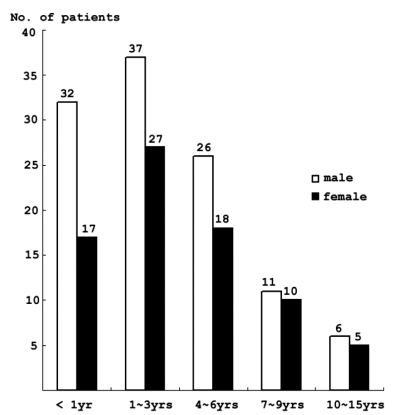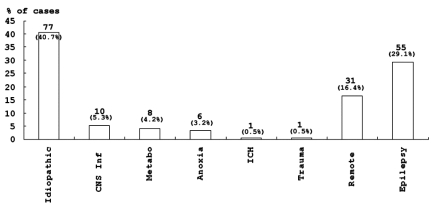Yonsei Med J.
2005 Feb;46(1):27-33. 10.3349/ymj.2005.46.1.27.
Prognostic Factors of Status Epilepticus in Children
- Affiliations
-
- 1Department of Pediatrics, Institute of Handicapped Children, Yonsei University College of Medicine, Seoul, Korea. joonsl96@yumc.yonsei.ac.kr
- KMID: 2158109
- DOI: http://doi.org/10.3349/ymj.2005.46.1.27
Abstract
- We retrospectively reviewed the medical records of 189 children who were admitted to the Pediatric Neurology Department at Yonsei University College of Medicine with status epilepticus (SE) between April, 1994 and April, 2003. The children were followed up for a mean duration of 17 months. We analyzed the clinical findings and the relationships between neurologic sequelae, recurrence, age of onset, presumptive causes, types of seizure, seizure duration and the presence of fever. Mean age at SE onset was 37 months. Incidences by seizure type classification were generalized convulsive SE in 73.5%, and non-convulsive SE in 26.5%. The incidences of presumptive causes of SE were idiopathic 40.7%, epilepsy 29.1%, remote 16.4% and acute symptomatic in 13.3%. Among all the patients, febrile episodes occurred in 35.4%, especially in patients under 3 year old, and 38.4% of these were associated with febrile illness regardless of presumptive cause. Neurologic sequelae occurred in 33% and the mortality rate was 3%. Neurologic sequelae were lower in patients that presented with an idiopathic etiology and higher in generalized convulsive SE patients. The recurrence of SE was higher in patients with a remote symptomatic epileptic etiology, and generalized convulsive SE showed higher rates of recurrence. Based on this retrospective study, the neurologic outcomes and recurrence of SE were found to be strongly associated with etiology and seizure type. Age, seizure duration and the presence of febrile illness were found to have no effect on outcome.
Keyword
MeSH Terms
Figure
Reference
-
1. Hauser WA. Status epilepticus:epidemiologic considerations. Neurology. 1990; 40(Suppl 2):9–13. PMID: 2185441.2. Shinnar S, Berg AT, Moshe SL, O'Dell C, Alemany M, Newstein D, et al. The risk of seizure recurrence after a first unprovoked afebrile seizure in childhood: an extended follow-up. Pediatrics. 1996; 98:216–225. PMID: 8692621.
Article3. Hauser AW, Anderson VE, Loewenson RB. Seizure recurrence after a first unprovoked seizure. N Engl J Med. 1982; 307:522–528. PMID: 7099224.
Article4. Berg AT, Shinnar S, Levy SR, Testa FM. Status epilepticus in children with newly diagnosed epilepsy. Ann Neurol. 1999; 45:618–623. PMID: 10319884.
Article5. Cascino GD, Hesdorffer D, Logroscino G, Hauser WA. Morbidity of nonfebrile status epilepticus in Rochester, Minnesota, 1965-1984. Epilepsia. 1997; 39:829–832. PMID: 9701372.
Article6. Towne AR, Pellock JM, Ko D, DeLorenzo RJ. Determinants of mortality in status epilepticus. Epilepsia. 1994; 35:27–34. PMID: 8112254.
Article7. Logroscino G, Hesdorffer DC, Cascino G, Annegers JF, Hauser WA. Short-term mortality after a first episode of status epilepticus. Epilepsia. 1997; 38:1344–1349. PMID: 9578531.
Article8. DeLorenzo RJ, Pellock JM, Towne AR, Boggs JG. Epidemiology of status epilepticus. J Clin Neurophysiol. 1995; 12:316–325. PMID: 7560020.
Article9. Maytal J, Shinnar S, Mosche SL, Alvarez LA. Low morbidity and mortality of status epilepticus in children. Pediatrics. 1989; 83:323–331. PMID: 2919138.
Article10. Proposal for revised clinical and electrophysiologic classification of epileptic seizure: from the Commission on Classification and Terminology of the International League Against Epilepsy. Epilepsia. 1981; 22:489–501. PMID: 6790275.11. Dodson WE, DeLorenzo RJ, Pedley TA, Shinnar S, Treiman DM, Wannamaker BB. Treatment of convulsive status epilepticus: Recommendation of the Epilepsy Foundation of America Working Group on Status Epilepticus. JAMA. 1993; 270:854–859. PMID: 8340986.12. Shorvon S. Status epilepticus : its clinical features and treatment in children and adults. 1994. Cambridge, England: Cambridge University Press.13. Bleck TP. Convulsive disorders:Status epilepticus. Clin Neuropharmacol. 1991; 14:191–198. PMID: 2070361.14. Treiman DM, Meyers PD, Walton NY, Collins JF, Colling C, Rowan AJ, et al. A comparison of four treatments for generalized convulsive status epilepticus. N Engl J Med. 1998; 339:792. PMID: 9738086.
Article15. Lowenstein DH, Bleck T, Macdonald RL. It's time to revise the definition of status epilepticus. Epilepsia. 1999; 40:120–122. PMID: 9924914.
Article16. DeLorenzo RJ, Garnett LK, Towne AR, Waterhouse EJ, Boggs JG, Morton L, et al. Comparison of status epilepticus with prolonged seizure episodes lasting from 10 to 29 minutes. Epilepsia. 1999; 40:164–169. PMID: 9952262.
Article17. Treiman DM. Laidlaw J, Richens A, Chadwick D, editors. Status epilepticus. A Textbook of Epilepsy. 1993. 4th ed. Edinburgh, Scotland: Churchill Livingstone;p. 205–220.
Article18. DeLorenzo RJ, Hauser WA, Towne AR, Boggs JG, Pellock JM, Penberthy L, et al. A prospective, population-based epidemiologic study of status epilepticus in Richmond, Virginia. Neurology. 1996; 46:1029–1035. PMID: 8780085.
Article19. Hesdorffer DC, Logroscino G, Cascino G, Annegers JF, Hauser WA. Incidence of status epilepticus in Rochester, Minnesota, 1965-1984. Neurology. 1998; 50:735–741. PMID: 9521266.
Article20. Coeytaux A, Jallon P, Galobardes B, Morabia A. Incidence of status epilepticus in French-speaking Switzerland: EPISTAR. Neurology. 2000; 55:693–697. PMID: 10980736.
Article21. Shorvon S. The management of status epilepticus. J Neurol Neurosurg Psychiatry. 2001; 70(Suupl 2):II22–II27. PMID: 11385046.
Article22. Fountain NB. Status epilepticus: risk factors and complications. Epilepsia. 2000; 41(Suppl 2):S23–S30. PMID: 10885737.
Article23. Shinnar S, Pellock JM, Moshe SL, Maytal J, O'Dell C, Driscoll SM, et al. In whom does status epilepticus occur. Age related difference in children. Epilepsia. 1997; 38:907–914. PMID: 9579892.24. Hauser WA. Delgado-Escueta AV, Wasterlain CG, Treiman DM, editors. Status epilepticus, frequency, etiology and neurological sequelae. Status epilepticus, advance in neurology. 1983. 34. New York: Raven Press;p. 3–14.25. Shinnar S, Maytal J, Krasnoff L, Mosche SL. Recurrent status epilepticus in children. Ann Neurol. 1992; 31:598–604. PMID: 1514772.
Article26. Driscoll SM, Towne AR, Pellock JM, DeLorenzo RJ. Recurrent status epilepticus in children(Abstract). Neurology. 1990; 40(Suppl 1):297.27. Daniel HL, Brian KA. Status epilepticus. N Engl J Med. 1998; 338:970–976. PMID: 9521986.
Article28. Mazarati AM, Baldwin RA, Sankar R, Wasterlain CG. Time-dependent decrease in the efficacy of antiepileptic drug during the course of self sustaing status epilepticus. Brain Res. 1998; 814:179–185. PMID: 9838100.29. Macdonald RL, Kapur J. Acute cellular alterations in the hippocampus after status epilepticus. Epilepsia. 1999; 40(Suppl 1):S9–S20. PMID: 10421557.
Article30. Bleck TP. Refractory status epilepticus in 2001[editorial]. Arch Neurol. 2002; 59:188–189. PMID: 11843688.31. Walton NY, Treiman DM. Motor and electroencephalographic response of refractory experimental status epilepticus in rats to treatment with MK-801, diazepam or MK-801 plus diazepam. Brain Res. 1991; 553:97–104. PMID: 1933279.
Article32. Borris DJ, Bertram EH, Kapur J. Ketamine controls prolonged status epilepticus. Epilepsy Res. 2000; 42:117–122. PMID: 11074184.
Article33. Perl TM, Bedard L, Kosatsky T, Hockin JC, Todd EC, Remis RS. An outbreak of toxic encephalopathy caused by eating mussels contaminated with domoic acid. N Engl J Med. 1990; 322:1775–1780. PMID: 1971709.
Article34. Teitelbaum JS, Zatorre RJ, Carpenter S, Gendron D, Evans AC, Gjedde A, et al. Neurologic sequelae of domoic acid intoxication due to the ingestion of contaminated mussels. N Engl J Med. 1990; 322:1781–1787. PMID: 1971710.
Article35. Lothman EW, Bertram EH III, Stringer JL. Functional anatomy of hippocampal seizure. Prog Neurobiol. 1991; 37:1–82. PMID: 1947175.36. Maytal J. The management of status epilepticus in children. Child Hosp Q. 1991; 3:255–263.37. Jagoda A, Riggio S. Refractory status epilepticus in adults. Ann Emerg Med. 1993; 22:1337–1348. PMID: 8333641.
Article38. Corsellis JAN, Bruton CJ. Delagado-Escueta AV, Wasterlain CG, Treiman DM, Porter RJ, editors. Neuropathology of status epilepticus in human. Advance in neurology. Vol 34. status epilepticus: mechanisms of brain damage and treatment. 1983. NewYork: Raven Press;p. 129–139.39. Sloviter RS. "Epileptic" brain damage in rats induced by sustained electrical stimulation of the perfortant path. I. Acutr electrophysiological and light microscopic studies. Brain Res Bull. 1983; 10:675–697. PMID: 6871737.40. Roberts MR, Eng-Bourquin J. Status epilepticus in children. Emerg Med Clin North Am. 1995; 13:489–507. PMID: 7737031.
Article41. Treiman DM. Generalized convulsive status epilepticus in adult. Epilepsia. 1993; 34(Suppl 1):S29–S41. PMID: 7681771.42. Wasterlain CG. Mortality and morbidity from serial seizures; an experimental study. Epilepsia. 1974; 15:155–176. PMID: 4525503.43. Nevander G, Ingvar M, Auer R, Siesjo BK. Status epilepticus in well-oxygenated rats causes neuronal necrosis. Ann Neurol. 1985; 18:281–290. PMID: 4051457.
Article44. Leppik IE. Status epilepticus: the next decade. Neurology. 1990; 40(Suppl 2):4–9. PMID: 2185439.45. Celesia GG. Prognosis in convulsive status epilepticus. Adv Neurol. 1983; 34:55. PMID: 6829360.46. Yager JY, Cheang M, Seshia SS. Status epilepticus in children. Can J Neurol Sci. 1988; 15:402. PMID: 3208225.
Article47. Koul RL, Raj Aithala G, Chacko A, Joshi R, Seif Elbualy M. Continuous midazolam infusion as treatment of status epilepticus. Arch Dis Child. 1997; 76:445–448. PMID: 9196363.
Article48. Aminoff MJ, Simon RP. Status epilepticus: cause,clinical features and consequences in 98 patients. Am J Med. 1980; 69:657–666. PMID: 7435509.49. Oxybury JM, Whitty CWM, Logroscino G, Hauser WA. Treatment of nonfebrile status epilepticus in Rochester, Minn, from 1965 through 1984. Mayo Clin Proc. 2001; 76:39–44. PMID: 11155411.50. Lacroix J, Deal C, Gauthier M, Rousseau E, Farrel CA. Admissions to a pediatric intensive care unit for status epilepticus: a 10-year experience. Crit Care Med. 1994; 22:827–832. PMID: 8181292.51. Verity CM, Ross EM, Golding J. Outcome of childhood status epilepticus and lengthy febrile convulsion: findings of national cohort study. BMJ. 1993; 307:225–228. PMID: 8369681.52. Gross-Tsyr V, Shinnar S. Convulsive status epilepticus in children. Epilepsia. 1993; 34(suppl 1):S12–S20.
Article53. DeLorenzo RJ, Towne AR, Pellock JM, Ko D. Status epilepticus in children,adults, and the elderly. Epilepsia. 1992; 33(Suppl 4):S15–S25. PMID: 1425490.
- Full Text Links
- Actions
-
Cited
- CITED
-
- Close
- Share
- Similar articles
-
- The presumptive causes and prognostic factors of status epilepticus in children
- Sevoflurane for the Management of Refractory Status Epilepticus : A case report
- Clinical Study of Status Epilepticus in Children
- A Case of Complex Partial Status Epilepticus
- Isoflurane Anesthesia Therapy for Nonconvulsive Status Epilepticus Continuing after the Control of Convulsive Status Epilepticus: A case report




